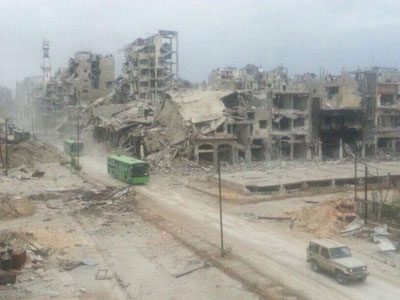DAMASCUS — Syrian forces took full control on Thursday, May 8, over Homs, a city once associated with the some of the earliest anti-government protests but now famed for images of ruin that epitomize the brutality of Syria’s civil war.
After holding the Old City of Homs for nearly two years, around 1,200 rebel fighters and trapped civilians boarded buses which took them out of the “capital of the revolution” in convoys on Wednesday and Thursday, activists said.
They were driven to rebel-held territory outside the city under a deal agreed between the insurgents and forces loyal to President Bashar al-Assad.
“Old Homs has been completely cleansed of armed terrorist groups,” state television said.
Homs provincial governor Talal Barazi said earlier on Thursday that Homs would be “declared a secure city” and reconstruction would commence after the evacuation.
Although the area had been cleared of insurgents, the army is not expected to move into the Old City until Friday when it will be checked for explosives.
Rebels smiled to cameras as they left, but the fall of Syria’s third largest city to government forces is a major blow to the opposition and a boost for Assad weeks before his likely re-election.

Over a year ago, government forces laid siege to the Old City after it was captured by rebels and residents said they starved.
On Thursday, the city was close to silent with no sound of gunfire or explosions. Many buildings at the entrance to the Old City district lay in ruins, destroyed by three years of fighting.
Hizbullah’s al-Manar television aired footage from Homs of a line of rebel fighters, some carrying guns and wearing scarves around their faces, walking to green buses, passing government troops.
Assad advances
At the same time as rebels were evacuated from Homs, dozens of captives held by rebels in the northern provinces of Aleppo and Latakia were freed as part of the same deal.
Governor Barazi told state media that 70 people abducted by rebels were released, including five children and 17 women, and state television said more people were later released from Latakia on Thursday.
The Homs evacuation comes after months of gains by the army, backed by its Lebanese ally Hizbullah, along a strategic corridor of territory linking the capital Damascus with Homs and on to Assad’s Alawite heartland on the Mediterranean.
Assad’s forces now control most of the capital, along with the main highway from Damascus to the coast, while rebels control much of the desert in the north and east. Syria’s second city, Aleppo in the northwest, is contested.
Many areas in Homs province remain in rebel hands, including the stronghold town of Rastan, and Assad will also need to secure rural areas around the capital to take full control of areas the Syrian army has been battling for. Government forces have also lost ground in the south to Islamist brigades.
Assad is widely expected to be the runaway victor in the June 3 presidential vote, which his opponents at home and abroad have dismissed as a charade.
They say no credible election can be held in a country fractured by civil war, with swathes of territory outside government control, 6 million people displaced and another 2.5 million refugees abroad.
More than 150,000 people have died in the conflict. Millions more have fled their homes and fighting regularly kills more than 200 people a day.
On Thursday, rebels detonated a huge bomb underneath an Aleppo hotel used by President Bashar al-Assad’s forces, destroying it and damaging other buildings on the edge of the city’s medieval citadel.
The rebel Islamic Front, which claimed responsibility for the explosion, published video footage which showed a huge column of debris and dust erupting into the Aleppo skyline.
It said 50 soldiers were killed in the blast but did not say how it arrived at that death toll.
The Syrian Observatory for Human Rights, which monitors the violence through a network of security and medical sources and activists across Syria, said at least 14 members of the security forces were killed.
It said Islamist fighters had placed explosives in a tunnel underneath the Carlton Hotel, which it said was used by Assad’s forces as a military base in the government-controlled area of the city.
Thursday’s explosion appeared similar in execution to a blast on Tuesday outside the town of Ma’arat al-Nu’man in the northwestern province of Idlib, where rebels buried explosives in a tunnel under a checkpoint, killing 30 government fighters.
U.S. to recognize opposition offices as foreign mission
The United States said on Monday it would recognize the main opposition Syrian National Coalition offices as a diplomatic foreign mission and announced plans for a $27 million increase in non-lethal assistance to moderate rebels.
The announcement came at the start of a visit to Washington by a Syrian opposition delegation led by Ahmad Jarba, president of the coalition, also known as the Syrian Opposition Coalition. He is set to meet U.S. Secretary of State John Kerry on Thursday.
State Department spokeswoman Marie Harf said the representative offices of the coalition would now be considered a “foreign mission” under U.S. law.
She said it was another move aimed at formalizing the relationship between Washington and the coalition, which until now has been represented by liaison offices in Washington and New York.
The change is largely symbolic and does not mean that the United States is now recognizing the opposition as Syria’s government.
“This is not tantamount to recognition of the SOC as the government of Syria,” Harf told a daily briefing. “It’s a reflection of our partnership with the coalition as the legitimate representative of the Syrian people.”






Leave a Reply